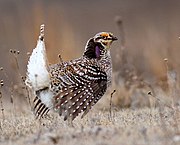Tympanuchus
| Tympanuchus | |
|---|---|

| |
| Male lesser prairie chicken (T. pallidicinctus) | |
| Scientific classification | |
| Domain: | Eukaryota |
| Kingdom: | Animalia |
| Phylum: | Chordata |
| Class: | Aves |
| Order: | Galliformes |
| Family: | Phasianidae |
| Tribe: | Tetraonini |
| Genus: | Tympanuchus Gloger, 1841 |
| Type species | |
| Tetrao cupido Linnaeus, 1758
| |
| Species | |
|
Tympanuchus cupido | |
| Synonyms | |
|
Pedioecetes | |
Tympanuchus is a small genus of birds in the grouse family. They are commonly referred to as prairie-chickens.
Taxonomy
[edit]The genus Tympanuchus was introduced in 1841 by the German zoologist Constantin Wilhelm Lambert Gloger for the greater prairie chicken.[1][2] The name combines the Ancient Greek tumpanon meaning "kettle-drum" with ēkheō meaning "to sound".[3]
The genus contains three species:[4]
| Common name | Scientific name and subspecies | Range | Size and ecology | IUCN status and estimated population |
|---|---|---|---|---|
| Sharp-tailed grouse | Tympanuchus phasianellus (Linnaeus, 1758) Seven subspecies
|
north to Alaska, south to California and New Mexico, and east to Quebec, Canada
|
Size: Habitat: Diet: |
LC
|
| Greater prairie-chicken | Tympanuchus cupido (Linnaeus, 1758) Three subspecies
|
Central U.S., formerly to the Atlantic coast
|
Size: Habitat: Diet: |
NT
|
| Lesser prairie-chicken | Tympanuchus pallidicinctus (Ridgway, 1873) |
western Oklahoma, the Texas Panhandle including the Llano Estacado, eastern New Mexico, and southeastern Colorado.
|
Size: Habitat: Diet: |
VU
|
All three are among the smaller grouse, from 40 to 43 cm (16 to 17 in) in length. They are found in North America in different types of prairie. In courtship display on leks, males make hooting sounds and dance with the head extended straight forward, the tail up, and colorful neck sacks inflated (shown in the photograph at upper right). Tympanuchus comes from Ancient Greek roots and means "holding a drum"; it refers to the membranous neck sacks and the drum-like call of the greater prairie chicken.
The two prairie chickens are particularly closely related and look extremely similar. But their taxonomy and the evolutionary relationships of the Tympanuchus is yet to be discovered. There is still unknown information about these genera. But one thing we do know is that Tympanuchus are polyphyletic. They have a strong sexual selection (Galla, 2013).
They are commonly seen in the North American Prairies (Galla, 2013).
The extinct heath hen of the American East Coast, usually considered a subspecies of the greater prairie chicken, has been considered a separate species.
References
[edit]- ^ Gloger, Constantin Wilhelm Lambert (1841). Gemeinnütziges Hand- und Hilfsbuch der Naturgeschichte (in German). Vol. 1. Breslau: A. Schulz. p. 396.
- ^ Peters, James Lee, ed. (1934). Check-List of Birds of the World. Vol. 2. Cambridge, Massachusetts: Harvard University Press. p. 41.
- ^ Jobling, James A. (2010). The Helm Dictionary of Scientific Bird Names. London: Christopher Helm. p. 393. ISBN 978-1-4081-2501-4.
- ^ Gill, Frank; Donsker, David; Rasmussen, Pamela, eds. (July 2021). "Pheasants, partridges, francolins". IOC World Bird List Version 11.2. International Ornithologists' Union. Retrieved 11 October 2021.
- Galla, S. J. (2013). Exploring the evolutionary history of north american prairie grouse using multi-locus coalescent analyses (Order No. 1524962).
- Holloway, Joel Ellis (2003). Dictionary of Birds of the United States: Scientific and Common Names. Timber Press. p. 206. ISBN 0-88192-600-0.
- Peterson, Alan P. (Editor). 1999. Zoological Nomenclature Resource (Zoonomen). Accessed 2007-07-29.
- Sibley, David (2000). The Sibley Guide to Birds. Knopf. pp. 146–147. ISBN 0-679-45122-6.
- Storch, Ilse; Bendell, J. F. (2003). "Grouse". In Christopher Perrins (ed.). Firefly Encyclopedia of Birds. Firefly Books. pp. 184–187. ISBN 1-55297-777-3.







